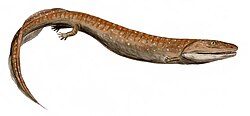| Baphetoidea Temporal range: Early to Late Carboniferous | |
|---|---|
 | |
| Life restoration of Loxomma | |
| Scientific classification | |
| Domain: | Eukaryota |
| Kingdom: | Animalia |
| Phylum: | Chordata |
| Clade: | Sarcopterygii |
| Clade: | Tetrapodomorpha |
| Clade: | Stegocephali |
| Superfamily: | † Baphetoidea Cope, 1875 |
| Families and genera | |
| |
| Synonyms | |
| |
Baphetoidea is a superfamily of stem-tetrapods. It includes the family Baphetidae and several more basal genera such as Eucritta and Spathicephalus (which has been given its own family Spathicephalidae). [1] The superfamily has also been called Loxommatoidea, but this name is a junior synonym of Baphetoidea.





